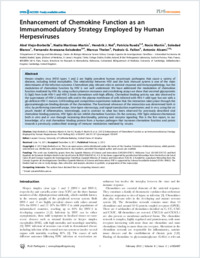Enhancement of chemokine function as an immunomodulatory strategy employed by human herpesviruses
- Viejo-Borbolla, Abel Department of Virology and Microbiology, Centro de Biología Molecular Severo Ochoa, Consejo Superior de Investigaciones Científicas, Universidad Autónoma de Madrid, Madrid, Spain
- Martinez-Martín, Nadia Department of Virology and Microbiology, Centro de Biología Molecular Severo Ochoa, Consejo Superior de Investigaciones Científicas, Universidad Autónoma de Madrid, Madrid, Spain
- Nel, Hendrik J. School of Medicine, St James's Hospital, Trinity College Dublin, Dublin, Ireland
- Rueda, Patricia Viral Pathogenesis Laboratory, Institute Pasteur, Paris, France, INSERM U819, Paris, France
- Martín, Rocío Department of Virology and Microbiology, Centro de Biología Molecular Severo Ochoa, Consejo Superior de Investigaciones Científicas, Universidad Autónoma de Madrid, Madrid, Spain
- Blanco, Soledad Department of Virology and Microbiology, Centro de Biología Molecular Severo Ochoa, Consejo Superior de Investigaciones Científicas – Universidad Autónoma de Madrid, Madrid, Spain
- Arenzana-Seisdedos, Fernando Viral Pathogenesis Laboratory, Institute Pasteur, Paris, France, INSERM U819, Paris, France
- Thelen, Marcus Institute for Research in Biomedicine (IRB), Faculty of Biomedical Sciences, Università della Svizzera italiana, Switzerland
- Fallon, Padraic G. School of Medicine, St James's Hospital, Trinity College Dublin, Dublin, Ireland
- Alcamí, Antonio Department of Virology and Microbiology, Centro de Biología Molecular Severo Ochoa, Consejo Superior de Investigaciones Científicas, Universidad Autónoma de Madrid, Madrid, Spain - Department of Medicine, University of Cambridge, Addenbrooke's Hospital, Cambridge, United Kingdom
-
02.02.2012
Published in:
- Plos pathogens. - 2012, vol. 8, no. 2, p. e1002497
English
Herpes simplex virus (HSV) types 1 and 2 are highly prevalent human neurotropic pathogens that cause a variety of diseases, including lethal encephalitis. The relationship between HSV and the host immune system is one of the main determinants of the infection outcome. Chemokines play relevant roles in antiviral response and immunopathology, but the modulation of chemokine function by HSV is not well understood. We have addressed the modulation of chemokine function mediated by HSV. By using surface plasmon resonance and crosslinking assays we show that secreted glycoprotein G (SgG) from both HSV-1 and HSV-2 binds chemokines with high affinity. Chemokine binding activity was also observed in the supernatant of HSV-2 infected cells and in the plasma membrane of cells infected with HSV-1 wild type but not with a gG deficient HSV-1 mutant. Cell-binding and competition experiments indicate that the interaction takes place through the glycosaminoglycan-binding domain of the chemokine. The functional relevance of the interaction was determined both in vitro, by performing transwell assays, time-lapse microscopy, and signal transduction experiments; and in vivo, using the air pouch model of inflammation. Interestingly, and in contrast to what has been observed for previously described viral chemokine binding proteins, HSV SgGs do not inhibit chemokine function. On the contrary, HSV SgGs enhance chemotaxis both in vitro and in vivo through increasing directionality, potency and receptor signaling. This is the first report, to our knowledge, of a viral chemokine binding protein from a human pathogen that increases chemokine function and points towards a previously undescribed strategy of immune modulation mediated by viruses.
- Language
-
- English
- Classification
- Medicine
- License
- Open access status
- gold
- Identifiers
-
- RERO DOC 326686
- DOI 10.1371/journal.ppat.1002497
- ARK ark:/12658/srd1319078
- Persistent URL
- https://n2t.net/ark:/12658/srd1319078
Statistics
Document views: 237
File downloads:
- Texte intégral: 191
